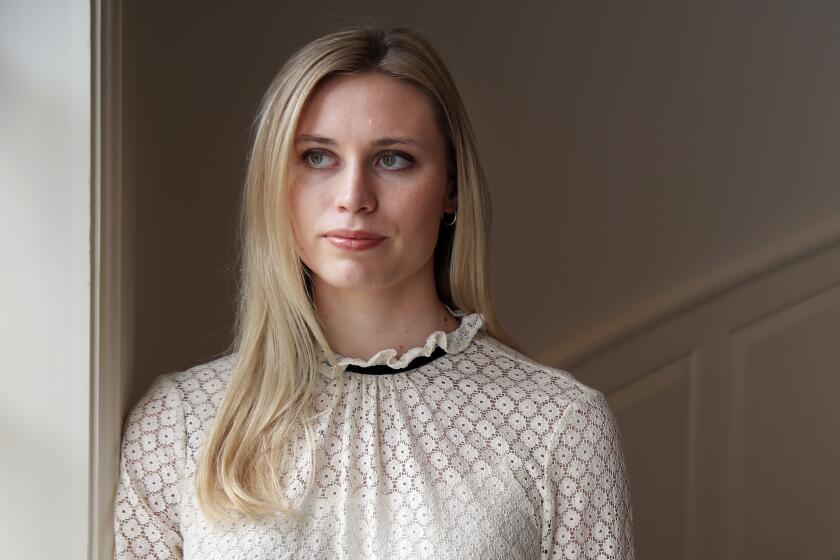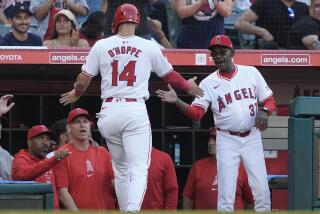Dominic Smith’s Baseball Generations offers diamond lifeline to disadvantaged L.A. youth
- Share via
The players arrive almost every afternoon at Holly Park, stretching out on one of the two baseball fields tucked between the 105 Freeway, two densely packed neighborhoods and a railroad track.
Some of them come from Orange County and South Bay beach towns. But many are products of this very part of the city, from Compton and South L.A. to Hawthorne, Gardena and Carson, baseball devotees in a region the sport slowly abandoned.
Dominic Smith was once like them, before he became a first-round draft pick of the New York Mets and a budding big league star. Back then, he was known as the kid who would watch games wearing his Little League jersey, who would practice in his backyard by throwing balls against a wall, who dreamed of one day making it in the sport he loved.
Now he’s a local icon, idolized in this corner of the baseball world by players who hope to one day be just like him.
So, three years ago, Smith and two of his childhood baseball friends, Ron Miller and Tim Ravare, decided to create an organization called Baseball Generations.
The idea was simple: help give young disadvantaged players the type of guidance neither Smith, the 11th overall selection in the 2013 draft, nor Miller, a former 10th-round pick and Marlins minor leaguer, nor Ravare, a former player at North Carolina A&T, received.
To keep baseball alive in the place they call home.
“Being able to travel in the minor leagues ... it just really opened my eyes. I saw that, especially if you live in the inner city, you’re at a huge disadvantage.”
— Mets first baseman Dominic Smith
“When we were coming up, we would just have to learn everything by ourselves,” Smith said. “I just want to give these kids a cheat sheet to being successful, whether it be in baseball or any facet of their life.”
Almost four years since its founding, Baseball Generations has grown from a small training program to a wide-ranging development organization that hosts camps for players from around the country, operates a nonprofit charity foundation and has attracted help from stars around the sport.
“We just noticed how in L.A., there was a lack of training and proper development for the youth levels,” Smith said. “That’s something we really wanted to change.”
::
The three friends originally met in the Ladera Little League, when they were all about 10 years old and played on different teams. Their first interactions came on the field, yelling and trash talking one another — until they recognized their shared passion for the sport.
“It was just the competitiveness we both brought to the game,” Ravare said. “That definitely made it fun for sure.”
Soon the trio was playing backyard Wiffle ball games and researching at-home training techniques online. None of them had a personal coach, or played for an expensive travel team, or had much of a clue about how to be scouted or recruited or noticed on the youth baseball circuit.
Instead, they created their own routines. They took swings in a batting net owned by one of Smith’s neighbors and ran sprints up and down some hills near his house. Miller’s dad built a back house where they lifted weights. Ravare made a weighted bat by taping layers of pennies around the barrel.
“Nothing was handed to us,” Ravare said.
Added Miller: “We were using what we had.”
It was a typical story for South L.A. players of their generation. Decades earlier, inner-city neighborhoods had been a breeding ground for some of the game’s biggest stars. Hall of Famers Ozzie Smith and Eddie Murray attended Locke High, near Watts. Mets and Dodgers great Darryl Strawberry came out of Crenshaw. Dodgers All-Star Reggie Smith played in Compton.
But those players were long retired once Dominic Smith and his friends picked up the sport. By then, the emergence of club teams and the travel ball system had made reaching the big leagues a much more complicated — and expensive — endeavor. Fewer South L.A. players went on to MLB careers. Fewer still returned to the area to help others follow their path.
It created a consequential cycle.
“In the inner city, there’s less resources for baseball,” Miller said. “There’s not a lot of pro guys that come back to the inner city and give back. There’s not a lot of training facilities. There’s just not a lot of good coaching. It hurts the baseball part of it.”
The three friends did catch a couple of key breaks.
While they were in middle school in 2006, MLB opened its first Urban Youth Academy in Compton. One day, a recruiter showed up at their Little League game and persuaded the boys’ parents to sign them up.
Over the next three years, the Academy helped them emerge as legitimate prospects. For the first time, they played in travel events. They attended USA Baseball camps. One year, they went to Australia for a tournament.
“They provided me with exposure, opportunities,” Smith said. “They just really helped me, especially being from the inner city and not having those same resources. I give them a ton of credit.”
“It gives you hope, watching other guys come from here. It makes you feel like you could do it too.”
— St. John Bosco junior Dylan Lina
The players were also coached by former minor league player Wil Aaron at Gardena Serra High, where they cemented their prospect status and won a Southern Section championship in 2013.
Ravare went on to play four seasons at North Carolina A&T, where he became a team captain. Miller was taken in the 10th round by the Marlins in 2012 and played a couple of seasons in the minors.
And Smith embarked on his career with the Mets, steadily improving since his 2017 debut. This year, he received MVP votes after posting a career-best .316 batting average, 10 home runs and 42 RBIs.
But the more their careers progressed, the more they were reminded of the obstacles they’d overcome, of the potholes that dotted their path simply because of where they were from.
“Being able to travel in the minor leagues, different states, see how it’s run, see how people live — it just really opened my eyes,” Smith said. “I saw that, especially if you live in the inner city, you’re at a huge disadvantage.”
::
The invitation first arrived in an Instagram message, from an organization Dylan Lina had never heard of.
This was two years ago, when Baseball Generations was just getting off the ground. It was seeking out players such as Lina — a budding high school prospect in Carson — to join its camps and training program, to accept the guidance the three co-founders were eager to provide.
Lina was intrigued and attended one of Baseball Generation’s All Star Games, an all-day event featuring top youth prospects from California and around the country and where MLB players such as Smith and Mariners Gold-Glove infielder J.P. Crawford, another South L.A. native, served as coaches.
There, Lina had an experience unlike any other. He finally met pro players he realized were just like him.
“They’re like one of us, it’s like a brotherhood,” said Lina, now a junior at Bellflower St. John Bosco who last year represented Team USA at a tournament in Mexico. “It gives you hope, watching other guys come from here. It makes you feel like you could do it too.”
That’s exactly what Smith, Miller and Ravare were hoping to provide with their fledgling organization. As Miller and Ravare’s careers wound down and Smith’s began to take off, all three wanted to give back.
When Smith, then in triple A, was selected for the Futures Game during All-Star Week in San Diego in 2016, Miller and Ravare drove down to meet him for dinner. There, they brainstormed the idea. A few months later, Baseball Generations was formed.
“We’d see the same things,” Miller said. “The kids didn’t really have guidance, they didn’t really know what to do, they don’t know what showcases to go to, that nobody’s talking to them. There’s not a lot of good trainers. That was the biggest reason we started, because we’ve seen it.”
They made rules that matched their mission. They bring on only current or former pro or college players as coaches to train their players, who range from 8 years old through high school. They offer free or subsidized fees for players in financial need. Smith has found willing volunteers in fellow MLB players eager to help out during the offseason.
“It’s like a proud Dad moment,” said Mike Rodriguez, a player agent at Roc Nation who represents Smith (he also represented Miller during his career) and whose agency has helped Baseball Generations organize events and attract sponsorship. “When they started this, they were 21 years old. … It’s really neat to see how all three of them play their role within this whole thing.”
Hayley Hodson was a ‘dream athlete’ and top student. But blows to the volleyball star’s head changed the course of her life. She’s suing Stanford.
Their usual summer camps — which in the past included as many 200 players — and travel teams were scaled back this year because of the COVID-19 pandemic. But the individual and small-group training continues at South L.A. fields such as Holly Park, located just down the street from Smith’s childhood home.
“Being around them, getting help from them and just supplying it to my game really gives me a lot of confidence,” said Tyresse Turner, a La Palma native and freshman shortstop at USC who trained with Baseball Generations from its inception and now also helps them coach.
“I’m getting information from guys who have been there before.”
To Smith, that’s what matters most.
“I didn’t grow up with money,” Smith said during a tearful Mets postgame interview in August, on a night he had decided to kneel during the national anthem in protest of police brutality and social inequality.
“That … doesn’t mean nothing to me. If you can give your time, that’s the thing that matters. That’s why I get emotional about it. Because people give their money and they leave. Can’t do that. You’ve got to be there for the children that’s coming up after us. That’s the biggest thing. If you give your time, that’s the only way we can change.”
Baseball Generations is the embodiment of that ethos, Smith’s way of trying to keep the game he loves from failing another young player.
“I just wanted to show the kids that, no matter what situation you’re in, we’re here to help,” he said. “We’re here for you guys.”
More to Read
Go beyond the scoreboard
Get the latest on L.A.'s teams in the daily Sports Report newsletter.
You may occasionally receive promotional content from the Los Angeles Times.












